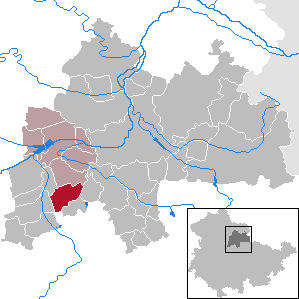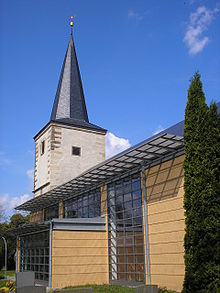Riethnordhausen (near Erfurt)
| coat of arms | Germany map | |
|---|---|---|

|
Coordinates: 51 ° 5 ' N , 11 ° 0' E |
|
| Basic data | ||
| State : | Thuringia | |
| County : | Sömmerda | |
| Management Community : | Straussfurt | |
| Height : | 160 m above sea level NHN | |
| Area : | 12.41 km 2 | |
| Residents: | 990 (Dec. 31, 2019) | |
| Population density : | 80 inhabitants per km 2 | |
| Postal code : | 99195 | |
| Area code : | 036204 | |
| License plate : | SÖM | |
| Community key : | 16 0 68 044 | |
| Association administration address: | Bahnhofstrasse 13 99634 Straussfurt |
|
| Website : | ||
| Mayor : | Jürgen Hieber | |
| Location of the municipality of Riethnordhausen in the district of Sömmerda | ||
The community Riethnordhausen (colloquially Nurzen ) with 988 inhabitants and an area of 1293 hectares is a member of the Straußfurt administrative community . It belongs to the Sömmerda district .
geography
Riethnordhausen is located in the Thuringian Basin , about ten kilometers north of Erfurt. The place is on the road 2142 between Straussfurt and Erfurt on the narrow Gera .
The neighboring communities are: Haßleben , Alperstedt , Nöda , Walschleben and Ringleben .
history
In the 12th century Riethnordhausen formed together with the neighboring Mittelhausen a "smaller county" owned by the Ludowingian landgraves of Thuringia . Both places were in the Treaty of Leipzig the Wettin possessions in 1485 to Ernestine Electorate of Saxony. From 1542 they belonged to the newly formed "Amt Ringleben ", which remained in the possession of the Ernestines after the Wittenberg surrender in 1547 and became part of the Duchy of Saxony-Weimar when Erfurt was partitioned in 1572 . After the death of Duke Wilhelm IV of Saxony-Weimar , the Ringleben office with its three locations was assigned to the newly created Duchy of Saxony-Eisenach in 1662 and in 1672 it was affiliated to the Großrudestedt office. From 1741 this belonged to Sachsen-Weimar-Eisenach . The place was assigned to the Weimar administrative district of the Grand Duchy of Saxony-Weimar-Eisenach in 1850 .
During the time of National Socialism there was discrimination against Sinti and Roma in the village . The visit to the grave of Wilhelm AJ Weiß was made much more difficult by police controls and harassment as well as arrests. This grave, marked by a carved violin (Wilhelm AJ Weiß is said to have been a gifted musician), became a “place of pilgrimage” in the area after his death.
In addition to such discrimination against the Sinti and Roma , around 22 Polish and 65 Russian slave laborers had to work in agriculture between 1940 and 1945. In March 1945, Kommando 51 was still in action with Soviet prisoners of war from Stalag IX C Bad Sulza .
coat of arms
Blazon : "In silver on a curved green shield base covered with a lying golden cattail, a blue-roofed church."
Culture and sights
The most important sight of the place is the St. Bonifatius Church , also known as the "Thuringian Lantern". It burned down almost completely in 1996 and has since been replaced by a new building. Only the church tower, visible from afar, was rebuilt true to the original. The new nave was built according to plans by the architects Schwarzkopf and Schinzel. Its specialty is a photovoltaic system on the entire southern half of the roof. In 2001 the church received a new organ from Orgelbau Waltershausen's workshop with two manuals, pedal and twelve stops.
In the cemetery, a tombstone with a violin motif commemorates the gifted violinist, the Sinto Wilhelm A. J. Weiß, who was buried here in 1899. Since then, many Sinti and Roma have visited the grave.
At the beginning of 2015, a building that has shaped the local history and appearance was demolished: the former community tavern , the “House of the Golden Lion”. It was a "magnificent and much-visited building".
Regular events
- Easter fire
- Summer party with a football leisure tournament
- Fun fair in October
Personalities
- Johann Philipp Bendeler (1654–1709), organist and organ theorist
- Wilhelm Weißenborn (1803–1878), theologian, philologist, historian, politician and member of the Frankfurt National Assembly
Web links
Individual evidence
- ^ Population of the municipalities from the Thuringian State Office for Statistics ( help on this ).
- ^ Paul Lehfeldt : Architectural and Art Monuments of Thuringia. Issue 16: Grand Duchy of Saxony-Weimar-Eisenach. District court districts Grossrudestedt and Vieselbach. Gustav Fischer, Jena 1892, p. 1 .
- ↑ Thuringian Association of the Persecuted of the Nazi Regime - Association of Antifascists and Study Group of German Resistance 1933–1945 (Ed.): Local history guide to sites of resistance and persecution 1933–1945. Thuringia . tape 8 . VAS - Publishing House for Academic Writings, Frankfurt am Main 2003, ISBN 3-88864-343-0 , p. 273 .
- ↑ Katrin Müller: The last gable falls. Demolition work in Riethnordhausen, which cost around 46,000 euros, will soon be finished. In: Thüringer Landeszeitung , from January 14, 2015.



